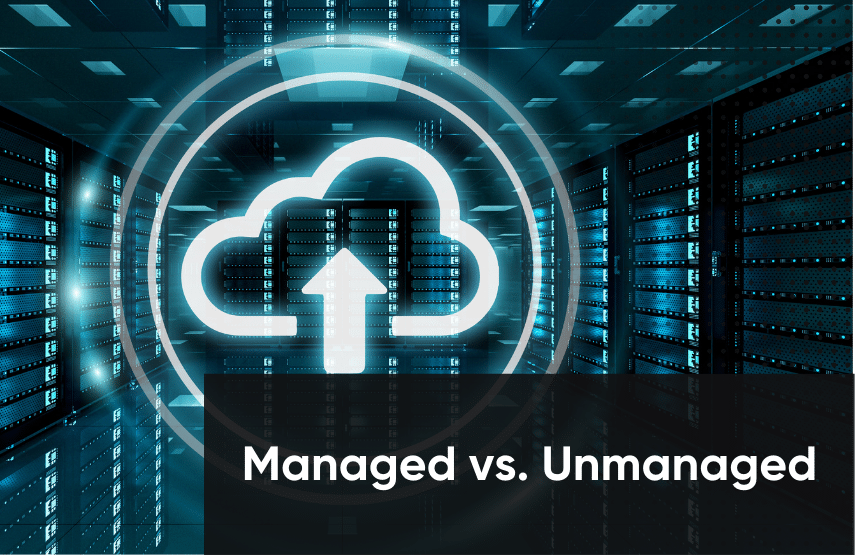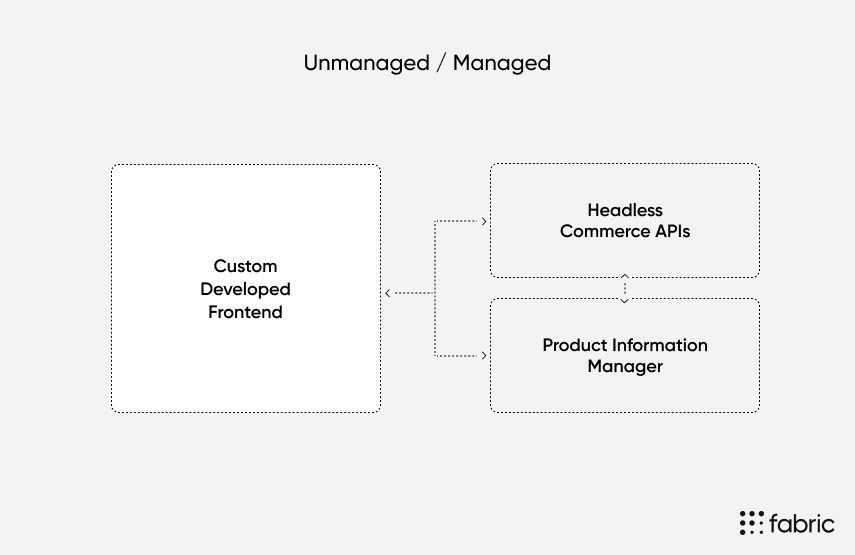Technical Considerations for Managed Vs. Unmanaged E-Commerce

[toc-embed headline=”Conclusion”]
If your business is competing in today’s digital economy, e-commerce needs to form part of your long-term strategy. The ability to sell goods and services 24 hours a day to a global market has many benefits, but deciding on the right technology can be challenging.
One of the critical strategic decisions you will need to make is choosing between a managed or unmanaged e-commerce solution. However, the advantages and disadvantages of each are not always clear.
This article will help you find clarity and present opportunities for using managed and unmanaged e-commerce solutions simultaneously.
[toc-embed headline=”Managed vs. Unmanaged E-Commerce”]
Managed vs. Unmanaged E-Commerce
Managed e-commerce
Managed platforms offer various benefits that organizations increasingly adopt this online retail model. As the platform provider maintains the underlying infrastructure, the organization can focus its e-commerce efforts on configuring a solution that aligns with its requirements.
In addition to freeing enterprises to concentrate on their core offering, managed e-commerce solutions also offer greater operational flexibility. As the platform provider is responsible for the underlying hardware and software, they cover core operational requirements like security, maintainability, and scalability. Furthermore, since an e-commerce solution’s success depends on its availability and capability to scale, managed platforms provide the agility online retailers need.
By leveraging the benefits of a managed e-commerce platform, enterprises can scale rapidly without the distraction of managing infrastructure. The advantage is evident with over 39% of all sites on the Internet adopting managed e-commerce platforms to sell their online goods and services to customers.
Unmanaged e-commerce
Unmanaged solutions, on the other hand, do not offer the same level of infrastructure freedom. Instead, enterprises are responsible for managing their online sales environment and underlying platform.
Although maintaining unmanaged e-commerce platforms can distract the enterprise from its core focus, they offer greater functional flexibility. This is why on-premise platforms like Oracle ATG were once popular when reliable cloud infrastructure did not exist. Another reason to use unmanaged e-commerce platforms is that managed platforms do not provide functionality that aligns with the unique requirements.
In these cases, the organizations may need to build and maintain an in-house e-commerce platform that meets their needs. Sometimes they will create from scratch, but more often, they will rely on open source software. However, as you will discover below, enterprise-level brands and retailers like these can use distinct managed e-commerce “microservices” to retain flexibility while outsourcing infrastructure and software management.
Before getting into this, though, let’s compare managed and unmanaged e-commerce solutions side by side:
|
Managed |
Unmanaged |
|
|
Customization and Features |
Limited to platform |
Unlimited |
|
Setup Difficulty |
Easy |
Difficult to Setup |
|
Technical Expertise |
Low |
Strong technical skills needed |
|
Infrastructure Maintenance |
Managed by Vendor/Provider |
Organization Responsible |
|
Security and Compliance |
Managed by Vendor/Provider |
Organization Responsible |
|
Cost |
Subscription-based |
High cost including custom development |
|
Vendor Support |
Dedicated Support depending on the vendor |
Community support if open source |
[toc-embed headline=”Types of Managed vs. Unmanaged E-Commerce”]
Types of Managed vs. Unmanaged E-Commerce
Managed e-commerce types
Managed e-commerce solutions utilize the advantages of cloud computing to provide their subscribers with a managed service. They typically take care of the underlying infrastructure and offer an online platform that you can configure.
However, not every managed platform provides the same scale and depth of functionality. Instead, they deliver a range of capabilities.
Managed e-commerce solutions include:
- Monolithic Platforms (Shopify Plus, SFCC)
- Smaller SaaS (Subscriptions, Product Reviews)
- Larger SaaS (PIM, OMS)
- APIs (cart API, shipping APIs)
Monolithic platforms
Monolithic e-commerce platforms offer a fully managed service that provides businesses with a feature-rich sales and marketing solution. Salesforce Commerce Cloud (SFCC) is an example of a monolithic platform used by enterprises, while Shopify Plus is an example of one used by smaller businesses.
The main advantage of these platforms is that you get a lot of commerce functionality in one place. On the other hand, the main disadvantage is that all this commerce functionality is tightly coupled together. This leads to vendor lock-in and makes it difficult to scale.
Smaller SaaS
When you start breaking down a monolith like Shopify Plus and adopting a flexible, microservices-based approach to e-commerce, you need smaller services to replace your Shopify plugins.
One of the best ways to acquire these services is through software-as-a-service (SaaS) providers. For instance, you could use fabric Subscriptions to replace a Shopify subscription plugin such as ReCharge.
Other smaller services that are managed and not platform-dependent include product review SaaS like Bazaarvoice and search functionality from Bloomreach. There is much cross-over between these smaller services and the “Microservice APIs” type below.
Larger SaaS
A Product Information Management (PIM) system like fabric PIM is an example of a larger e-commerce service that is platform agnostic.
This larger, distinct SaaS product provides online retailers with tools and processes that deliver a single, accurate view of all product data. It can replace the product management component in a monolith like Shopify Plus.
Other larger managed services include order management systems (OMS), pricing and promotion software, and loyalty management software like fabric Member. Again, cross-over between these larger services and microservice APIs occurs.
APIs
Headless Commerce APIs can deliver e-commerce-related functionality for organizations leveraging a microservices architecture or simply a headless CMS. Utilizing the same business model as other managed e-commerce solutions, APIs provide particular functionality such as shopping carts, orders, and shipping.
Enterprises building e-commerce solutions with a decoupled architecture can leverage these APIs, integrating the functionality they need instead of building it.
For example, fabric offers a suite of core E-Commerce APIs that enable the unification of multiple sales channels. By leveraging these APIs, organizations can take advantage of the benefits a microservices architecture offers without the risk and cost of building and maintaining the relevant components.
Unmanaged e-commerce types
Organizations can also leverage an unmanaged e-commerce solution to fulfill their online sales and marketing needs. In these instances, the enterprise manages the underlying hardware and software infrastructure.
Although these platforms require a higher degree of maintenance, there are particular use cases where using an unmanaged solution makes sense.
Unmanaged e-commerce solutions include:
- Custom Software (idiosyncratic tech, integrations)
- Open Source Software (nopCommerce, strapi)
Custom software
Unmanaged e-commerce solutions provide unlimited flexibility as organizations can craft solutions that align perfectly with their business model. Typically, organizations will utilize these solutions if managed platforms do not offer the unique functionality they need.
As enterprises develop these solutions in-house, they can hone the functionality to meet their precise requirements.
Another use case for leveraging an unmanaged solution is integration. For example, the organization may need to integrate its online sales and marketing capabilities with other custom solutions to run its business.
Open source software
Organizations that choose to leverage an unmanaged e-commerce platform can leverage a range of open source platforms and software. These solutions range from e-commerce frameworks like nopCommerce to a headless CMS such as strapi.
Since there are multiple open source products with differing levels of functionality, organizations need to consider their architecture before committing. For example, will a complete framework like nopCommerce fulfill every requirement, or will the need to build or integrate with another product.
[toc-embed headline=”Hybrid E-Commerce Solution”]
Hybrid E-Commerce Solution
As with many other cloud-based technologies, organizations have the option to adopt a hybrid approach and use a combination of managed and unmanaged e-commerce services.
For example, if an enterprise needs to sell products and services to different market segments, it may need to leverage two distinct platforms. The challenge with this approach is the duplication of effort, cost, and data.
Leveraging a microservices architecture with a hybrid approach could solve this problem elegantly and cost-effectively.
For example, as depicted in the image below, the enterprise may need to build an unmanaged frontend to meet its unique requirements. It could then leverage a managed PIM and microservice APIs to fulfill the core requirements of its e-commerce solution.

Conclusion
As long as the world continues to embrace digital solutions to communicate, learn, and transact, e-commerce solutions will remain a vital component of the global online economy. Enterprises that want to interact with their customers and sell products and services online can leverage either managed or unmanaged e-commerce platforms.
While a managed solution provides an easy-to-use configurable platform that allows an organization to focus on its core business, it may lack the flexibility needed in particular circumstances.
On the other hand, unmanaged solutions offer great business agility but are expensive to manage and maintain. Therefore, should an organization require a solution that must align with its unique requirements, a hybrid approach may be the best option.
By leveraging the best features of both managed and unmanaged e-commerce, you can build a solution that combines the cost-effectiveness and simplicity of a managed with the flexibility of an unmanaged.
Using fabric for managed e-commerce
fabric provides headless commerce APIs and managed commerce services that organizations can use to scale their commerce experiences. By decoupling core e-commerce components, fabric solutions allow for seamless flexibility without the limitations imposed by restrictive monolithic platforms.

Tech advocate and writer @ fabric.